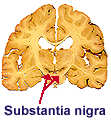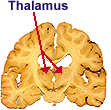Neuroscience for Kids Staff Writer
January 28, 2000
 Actor Michael J. Fox, age 38, announced Tuesday, January 18,
2000 that he would be leaving the hit TV series "Spin City" to deal with
his battle with Parkinson's disease. ABC said that it is unclear whether
the show will continue. Fox said that he will not be leaving acting,
producing, or directing. He emphasized that his condition is not getting
worse, but that he wants to spend more time
with his family. He also wants to promote awareness of Parkinson's disease
to speed the discovery of a cure.
Actor Michael J. Fox, age 38, announced Tuesday, January 18,
2000 that he would be leaving the hit TV series "Spin City" to deal with
his battle with Parkinson's disease. ABC said that it is unclear whether
the show will continue. Fox said that he will not be leaving acting,
producing, or directing. He emphasized that his condition is not getting
worse, but that he wants to spend more time
with his family. He also wants to promote awareness of Parkinson's disease
to speed the discovery of a cure.
Fox revealed in December of 1998 that he had Parkinson's disease for the past seven years. Fox starred in the popular 1980s TV show Family Ties and has been in numerous movies such as Back to the Future and its sequels and Doc Hollywood. It was during the filming of Doc Hollywood that Fox noticed a twitch in his left pinkie, a twitch that within six months spread to his whole hand.
 Parkinson's disease afflicts approximately 1
million to 1.5 million people in the U.S., most of who are 60 yrs-old or
older. The disorder is seen in people of all ethnic groups and among men
and women in equal numbers. There is no known cause and no cure, just
treatments to help control the symptoms of trembling arms and legs,
trouble speaking, and difficulty coordinating movement. The disease can
affect younger people such as Michael J. Fox. In fact, about 5-10% of
cases are diagnosed in people younger than 40 years of age. The
Parkinson's disease afflicts approximately 1
million to 1.5 million people in the U.S., most of who are 60 yrs-old or
older. The disorder is seen in people of all ethnic groups and among men
and women in equal numbers. There is no known cause and no cure, just
treatments to help control the symptoms of trembling arms and legs,
trouble speaking, and difficulty coordinating movement. The disease can
affect younger people such as Michael J. Fox. In fact, about 5-10% of
cases are diagnosed in people younger than 40 years of age. The  Parkinson's disease occurs
when neurons degenerate (lose the ability to function normally) in a part
of the brain called the substantia nigra. Many of
these neurons that degenerate contain the neurotransmitter called dopamine. As these neurons degenerate, dopamine levels
fall, and the balance between dopamine and other
neurotransmitters, such as acetylcholine, is thrown off. This leads to
muscles that do not work normally. Muscles may contract and relax, causing
shaking called tremors. Sometimes if muscles contract but do not relax
a part of the body can become rigid. Injections of dopamine do not fix this
deficiency because dopamine cannot cross the
Parkinson's disease occurs
when neurons degenerate (lose the ability to function normally) in a part
of the brain called the substantia nigra. Many of
these neurons that degenerate contain the neurotransmitter called dopamine. As these neurons degenerate, dopamine levels
fall, and the balance between dopamine and other
neurotransmitters, such as acetylcholine, is thrown off. This leads to
muscles that do not work normally. Muscles may contract and relax, causing
shaking called tremors. Sometimes if muscles contract but do not relax
a part of the body can become rigid. Injections of dopamine do not fix this
deficiency because dopamine cannot cross the  Research has shown that a surgery called
thalamotomy can often help people with Parkinson's disease regain control
over
their limbs. The thalamus is an oval shaped
structure in the forebrain; it is about 3 cm (1 inch) in length. The
thalamus acts as a relay station for sensory information, such as input
for touch, hearing, vision, and taste. It also functions in part to
interpret this information--is something hot or painful, for example. It
also plays a role in voluntary motor actions, such as when a person wants
to move a certain muscle (such as lifting an arm).
Research has shown that a surgery called
thalamotomy can often help people with Parkinson's disease regain control
over
their limbs. The thalamus is an oval shaped
structure in the forebrain; it is about 3 cm (1 inch) in length. The
thalamus acts as a relay station for sensory information, such as input
for touch, hearing, vision, and taste. It also functions in part to
interpret this information--is something hot or painful, for example. It
also plays a role in voluntary motor actions, such as when a person wants
to move a certain muscle (such as lifting an arm). Fox elected to have this surgery in 1998, and
had part of his thalamus removed. The surgery took four hours, during
which time Fox was awake to help the surgeons. As they located and
cauterized (using heat to destroy cells that were misfiring) the necessary
part of the thalamus, Fox gave important feedback as to what area of his
body was being affected by the work they were doing on his brain. At one
point, his speech began to slur, and the surgeons stopped working on that
area. The surgery was a success, freeing Fox of his most serious tremors.
The surgery has a 90% success rate, although there are risks: paralysis,
coma, or death.
Fox elected to have this surgery in 1998, and
had part of his thalamus removed. The surgery took four hours, during
which time Fox was awake to help the surgeons. As they located and
cauterized (using heat to destroy cells that were misfiring) the necessary
part of the thalamus, Fox gave important feedback as to what area of his
body was being affected by the work they were doing on his brain. At one
point, his speech began to slur, and the surgeons stopped working on that
area. The surgery was a success, freeing Fox of his most serious tremors.
The surgery has a 90% success rate, although there are risks: paralysis,
coma, or death.

![[email]](./gif/menue.gif)


